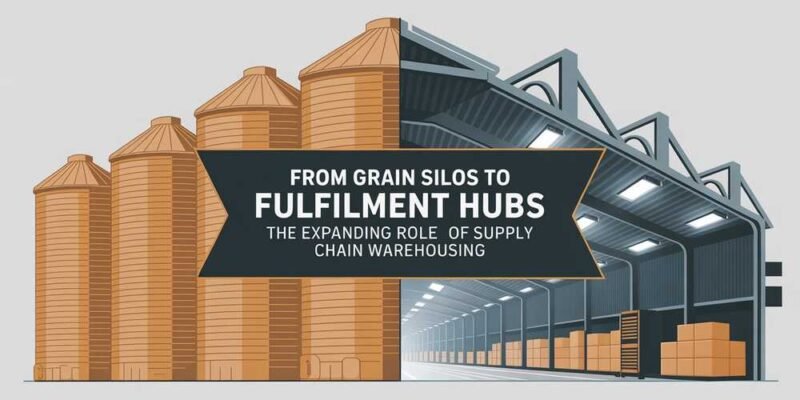Behind every click-to-ship delivery or store restock is an unsung hero—the warehouse. Whether in ancient civilizations or present-day industrial zones, supply chain warehousing has served as the silent enabler of trade. Today, modern storage solutions such as the plastic pallet box further enhance efficiency by protecting goods and streamlining handling. Its function has grown from mere storage to a highly coordinated process supporting global inventory flow, customer satisfaction, and business continuity.
Origins in Antiquity: The Early Architecture of Storage
Preserving Harvests: The Role of Granaries
Long before digital orders and forklifts, storage began with simple grain silos in early societies like Mesopotamia, Egypt, and the Indus Valley. These silos ensured food stability during droughts and enabled governments to control distribution.
The architecture included high platforms, sloped interiors, and clay seals—primitive methods of inventory protection. This early warehousing laid the groundwork for logistical foresight.
Temple Storehouses and Royal Reserves
Beyond food, ancient storehouses sheltered textiles, pottery, tools, and tribute offerings. Empires like Rome and China used massive storage buildings to centralize resources, support armies, and stabilize their economies.
Even at this stage, warehousing was more than shelter—it represented control, foresight, and state-level logistics.
The Rise of Commercial Warehousing: Trade Drives Innovation
Merchants and Maritime Networks
Due to the expansion of maritime trade, warehouses were crucial along the ports of Venice, Amsterdam, and Lisbon during the Middle Ages and the Renaissance. These structures were built near docks, allowing for fast offloading and temporary holding before distribution.
Here, supply chain warehousing took on a commercial role. It was no longer about storing government stockpiles—it became part of international trade.
Inventory Documentation and Early Recordkeeping
Manual ledgers tracked goods, shipments, and destinations. These records evolved into the first inventory control systems, emphasizing accuracy, rotation, and security.
The merchant warehouse became a blend of financial ledger, marketplace, and logistical node.
Industrial Revolution: Warehousing Becomes a Powerhouse
Engineering for Mass Production
With machines reshaping production, warehouses expanded rapidly. Structures grew taller, more durable, and strategically located near factories, railways, and shipyards. This was the birth of the industrial warehouse—a functional, large-scale space meant to serve multiple supply lines.
Steel framing, lifts, and conveyor belts became standard. As production soared, storage had to match in volume and speed.
Integrated Distribution Centers
Warehouses began coordinating inbound raw materials and outbound finished goods. They were no longer passive but redesigned for inventory flow, not just inventory hold. This paved the way for today’s distribution centers—a step beyond storage, offering sorting, dispatching, and logistics coordination.
Digital Transformation: The Rise of Smart Warehousing
Fulfillment Centers and E-Commerce Acceleration
The explosion of online shopping reshaped warehousing again. Modern consumers expect fast, accurate, and traceable deliveries. That expectation birthed fulfillment centers—warehouses designed to rapidly hold goods and pick, pack, and ship individual items.
Leaders like Amazon redefined the model. These facilities rely on real-time order processing, clever inventory placement, and integrated warehouse management systems (WMS) to reduce human error and boost output.
Automation and AI in Inventory Flow
Today’s warehouses integrate robotics, predictive analytics, and IoT sensors to manage inventory flow and demand forecasting. These tools enable:
- Dynamic inventory tracking
- Smart replenishment triggers
- Energy-efficient operations
Technology is shifting warehouses from reactive spaces into proactive, self-regulating ecosystems.
Functions That Anchor Supply Chain Success
Bridging Supply with Consumer Demand
Warehousing allows companies to hold stock during production lags or shipping delays. This buffering capacity ensures products are available when needed, even during spikes in demand.
It’s especially vital for seasonal industries like retail or agriculture, where timing is everything.
Enhancing Safety and Minimizing Risk
Warehouses protect against environmental exposure, spoilage, theft, and misplacement. Modern facilities are equipped with:
- Fire suppression systems
- Climate control units
- Security monitoring tools
They also serve as risk buffers during global disruptions, such as pandemics, labor strikes, or port congestion.
Innovations Shaping the Future of Warehousing
Urban Micro-Facilities for Faster Delivery
Companies are developing urban micro-warehouses to meet the same-day and next-day delivery demand. Located within city centers or near dense populations, these smaller hubs allow quicker dispatch while reducing shipping costs and emissions.
This marks a shift toward localized logistics—smaller footprints, tighter loops.
Collaborative Robotics
New robotics systems are designed to work alongside humans rather than replace them. These co-bots assist in picking, sorting, and packing, making operations more ergonomic and consistent.
The blend of human flexibility and robotic accuracy sets new standards in warehouse productivity.
Conclusion
Supply chain warehousing has adapted alongside civilization, from mud-brick granaries to AI-powered hubs. It has always been more than a storage solution—it signals how economies are built, maintained, and evolved.
As industries shift toward digital-first, experience-driven models, the warehouse remains essential, not as an afterthought, but as a core commerce engine. Its role will only deepen as consumer behavior reshapes the path between product and purchase.
Frequently Asked Questions
What is supply chain warehousing?
Supply chain warehousing refers to the strategic storage of goods within a more extensive logistics network. It supports order fulfillment, inventory control, and product protection.
How do modern warehouses differ from traditional ones?
Modern warehouses efficiently manage inventory using AI, robotics, and real-time tracking technology. They also offer services like sorting, labeling, and same-day fulfillment.
Why are micro-warehouses becoming popular?
Micro-warehouses enable faster delivery by placing goods closer to consumers in urban areas. This reduces shipping time and supports same-day or local delivery services.
What technologies are shaping the future of warehousing?
Innovations like predictive analytics, IoT sensors, robotics, and sustainable design are redefining how warehouses operate, making them smarter, faster, and greener.
Do Read: The Quiet Currency: How Informal Business Resources Shape Everyday Decisions













